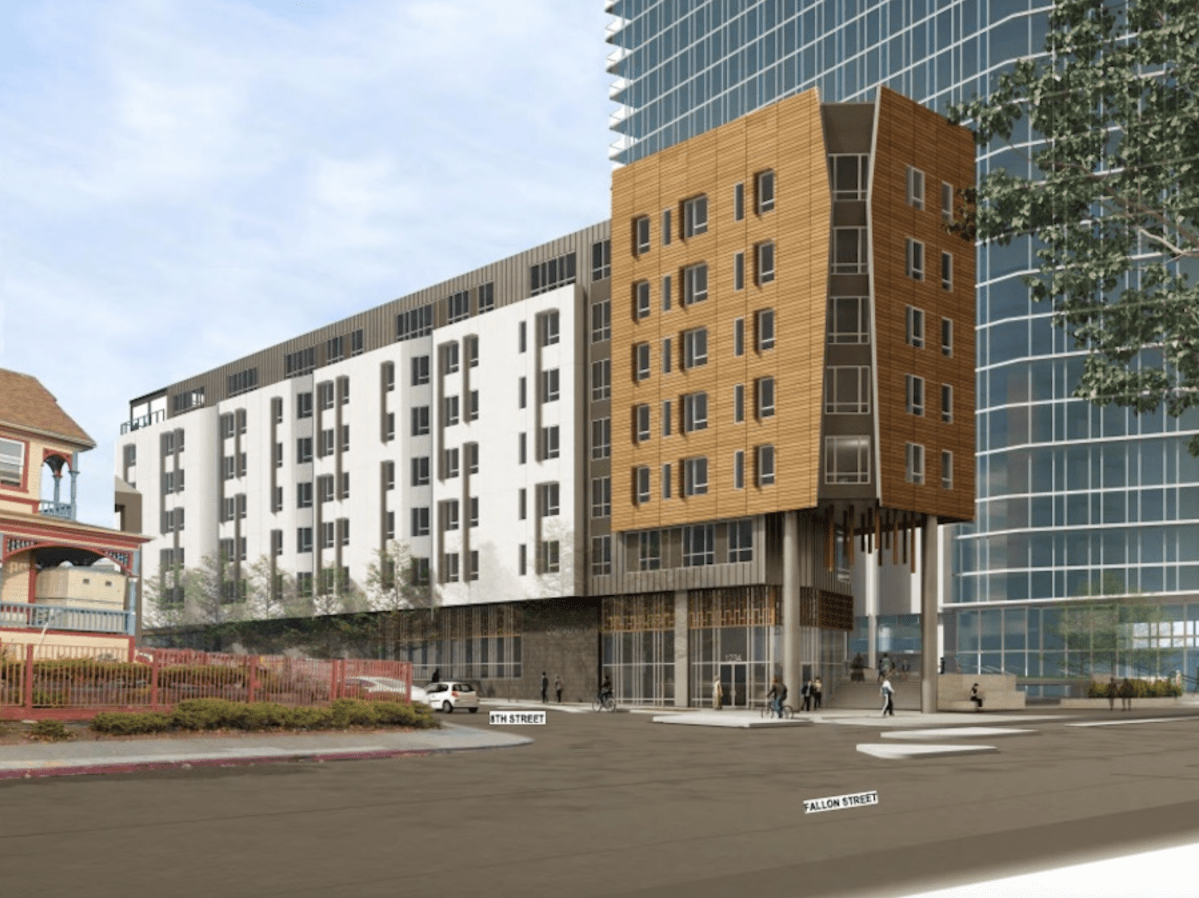Plans to develop hundreds of housing units and an office tower at the Lake Merritt BART station are creeping along, with an affordable apartment building for seniors coming up first.
The whole project will transform two full blocks of Chinatown over the next six or more years. Led by developers Strada and East Bay Asian Local Development Corporation (EBALDC), the plans approved in spring 2021 will result in 557 new apartments, 233 of which are priced for low-income residents, spread among three buildings.
The project also includes a 500,000 square foot office tower, as well as space for shops, a daycare, and 408 parking spaces. A “paseo” pedestrian path lined with plants will stretch between two of the buildings.
The initial, 97-unit senior development will be built on the current BART parking lot site bounded by Ninth, Fallon, Eighth, and Oak streets.
The project aims to not only “work for transit or new residents who will live here, but to make this a destination in its own right,” with a food court and other activities, said landscape architect Sarah Kuehl, at an Oakland Design Review Committee meeting on Wednesday.
Committee members were looking over the plans for EBALDC’s senior housing project before the full Planning Commission decides whether to grant a final permit later this summer.
The Lake Merritt project is one piece of BART’s expansive transit-oriented development plans. In 2016, the agency set a goal of building 20,000 housing units and 4.5 million square feet of commercial space on its property by 2040, with 35% of the housing affordable. According to the agency, the idea is to boost ridership and economic activity and build climate-friendly homes with immediate access to transit.
Kuehl said the Lake Merritt project will “reset” the station area so it signals, “This is a place for people to live.”
A site of past Chinese-American displacement

People have lived on these blocks in the past. In the 1960s, the brand-new Bay Area Rapid Transit acquired three blocks of Chinatown to build its Lake Merritt Station, an agency headquarters, and associated parking lots. To do so, BART tore down some 75 houses along with important community sites like an orphanage. An Episcopal church there had to move away, and Madison Square Park was relocated.
“The displaced Chinese households, along with other families and residents, spread to other parts of Oakland and beyond,” wrote planners in a report associated with the city’s broader Lake Merritt Station Area Plan. “The change was especially difficult for elderly Chinese… Moving away meant an inconvenience and a cultural and linguistic disruption.”
The developers and officials working on the new project should be cognizant of that historical context, said Steve Terusaki, board member of the neighboring Buddhist Church of Oakland.
“It really is a responsibility of the public agencies to respond and give back to the ‘take’ that happened in the 1960s in this urban renewal and building of the public infrastructure we have now,” Terusaki told The Oaklandside. “The Chinatown community took a big hit, and it really decimated the character of the neighborhood.” Members of the Buddhist temple can feel BART rumbling below the property, he said.
Terusaki was on the selection panel that chose EBALDC as the affordable housing developer for the BART project, and he’s optimistic that the nonprofit understands its mandate and will help create something beneficial for the area.
“I think it will go a long way toward helping to create safe streets and greater commercial activity that can be a benefit to residents,” he said. “This will put pressure on existing land owners to make sure their properties are kept up.”
Speaking at Wednesday’s meeting, BART Board Director Robert Raburn said the current plans are the result of dozens of community meetings over the past several years.
“There’s been a tremendous embracement of this project by the Oakland Chinatown,” he said.
Julia Liou, CEO of Asian Health Services, said her organization and the Oakland Chinatown Coalition collected input from hundreds of community members to come up with a vision for the project, including the 200 or so affordable apartments, space for nonprofits, and a contribution to Madison Square Park.
“It is critical that the development leverage the resiliency of Oakland Chinatown, which has thrived in spite of its history of eminent domain and misguided urban renewal,” she said in an email. The impact of the pandemic on the neighborhood only increases the need for a project that has space for local organizations and residents, Liou said.
“We see that establishing a footprint for service organizations, civic uses, and additional housing in this part of the neighborhood will help Chinatown stay vital for generations to come,” she said.
Potential next steps

If all pieces of the project receive final permits, construction on the 97-unit senior housing building would likely start in late 2023, according to developers. A 360-unit market-rate housing tower would be built on the same block starting in 2024.
The next phase of the project wouldn’t begin until 2026 at the earliest, because it requires the demolition of the old Metro Center building, currently the BART police headquarters. A large office building and a 100-unit affordable housing development for families will be built in its place. Asian Health Services also currently has office space in the Metro Center building, but according to project documents, their lease is up next year.
EBALDC recently received a $24.4 million state grant for the senior project. City planners have called the project “well-designed” but said they have some concerns about the materials and busy-ness of the design.
Abby Thorne-Lyman, BART’s real estate director, spoke at Wednesday’s meeting about the work that went into drawing up the plans.
“This is an incredibly challenging project to design, particularly designing over the tracks,” she said.
The senior housing project comes to the Planning Commission on July 6.

